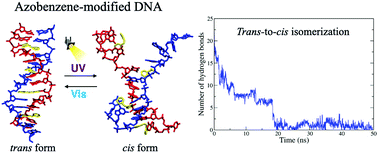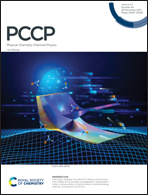Photoinduced azobenzene-modified DNA dehybridization: insights into local and cooperativity effects from a molecular dynamics study†
Abstract
Photoresponsive azobenzene-modified DNA (RNA) has become a very fruitful material for nanotechnology due to the capability of switching on and off hybridization (i.e., duplex formation) in smart nanostructures. This nanomaterial exploits the well-known azobenzene trans/cis photo-isomerization. In fact, it has been found that DNA tethered with trans-azobenzene shows normal nucleic acid recognition and hybridization, while the cis form destabilizes the duplex configuration, eventually leading to DNA unzipping. However, while the working principle of the light-triggered DNA dehybridization is apparent, specific details of this mechanism still remain elusive to experiments. Previous in silico studies successfully addressed some aspects (e.g., local structural effects, thermal stability, and early events of azobenzene photoisomerization) of this challenging molecular process characterized by timescales spanning several orders of magnitude, from picoseconds (i.e., azobenzene photoisomerization) to micro- and milli-seconds (i.e., complete strand detachment). In this work, inspired by a recent report by Asanuma and coworkers, we focus on the local and cooperativity effects played by multiple azobenzene units on a 10-mer azobenzene-modified DNA duplex. Using molecular dynamics (MD) simulations, we investigated nine systems equipped with a variable number (from 1 to 7) of photoswitch units and different configurations, focusing our analysis on the initial events (from few ps to hundreds of ns) characterizing DNA destabilization upon trans-to-cis isomerization, such as hydrogen bonding breakage and base pair misalignment. Results highlight, on one hand, the local effects of single azobenzene units on DNA duplex structure and, on the other hand, the cooperative role that multiple photoswitches show in enhancing and accelerating DNA dehybridization following trans-to-cis conversion, in agreement with previously reported data and observations.



 Please wait while we load your content...
Please wait while we load your content...